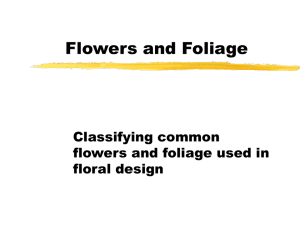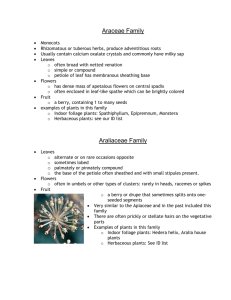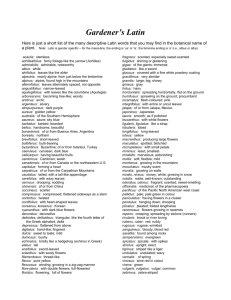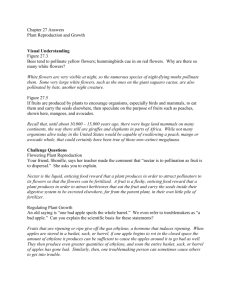treatment of cut flowers
advertisement
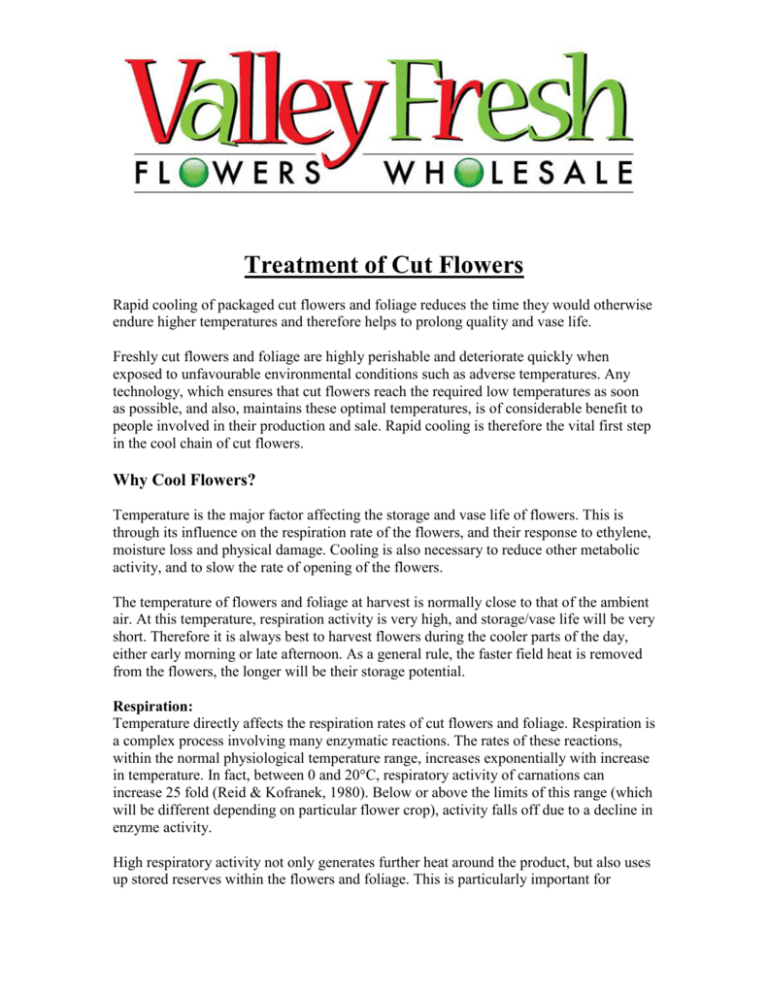
Treatment of Cut Flowers Rapid cooling of packaged cut flowers and foliage reduces the time they would otherwise endure higher temperatures and therefore helps to prolong quality and vase life. Freshly cut flowers and foliage are highly perishable and deteriorate quickly when exposed to unfavourable environmental conditions such as adverse temperatures. Any technology, which ensures that cut flowers reach the required low temperatures as soon as possible, and also, maintains these optimal temperatures, is of considerable benefit to people involved in their production and sale. Rapid cooling is therefore the vital first step in the cool chain of cut flowers. Why Cool Flowers? Temperature is the major factor affecting the storage and vase life of flowers. This is through its influence on the respiration rate of the flowers, and their response to ethylene, moisture loss and physical damage. Cooling is also necessary to reduce other metabolic activity, and to slow the rate of opening of the flowers. The temperature of flowers and foliage at harvest is normally close to that of the ambient air. At this temperature, respiration activity is very high, and storage/vase life will be very short. Therefore it is always best to harvest flowers during the cooler parts of the day, either early morning or late afternoon. As a general rule, the faster field heat is removed from the flowers, the longer will be their storage potential. Respiration: Temperature directly affects the respiration rates of cut flowers and foliage. Respiration is a complex process involving many enzymatic reactions. The rates of these reactions, within the normal physiological temperature range, increases exponentially with increase in temperature. In fact, between 0 and 20°C, respiratory activity of carnations can increase 25 fold (Reid & Kofranek, 1980). Below or above the limits of this range (which will be different depending on particular flower crop), activity falls off due to a decline in enzyme activity. High respiratory activity not only generates further heat around the product, but also uses up stored reserves within the flowers and foliage. This is particularly important for certain Protea and Leucadendron species that develop leaf blackening. This is thought to be a result of rapid depletion of stored carbohydrates from the leaves due to the high respiratory demand of the inflorescences at room temperature. Therefore, lowering product temperatures will decrease respiratory activity, which in turn will slow down the use of stored reserves and the generation of heat. Ethylene: Ethylene gas is a pollutant generated naturally by all vegetation, especially that which is cut and/or decaying, ripening fruit and vegetables, and some senescing flowers. It is also produced from coal gas, petroleum gas, and in exhaust fumes of internal combustion engines, such as those used in some forklifts, heating systems, etc. Ethylene reduces the longevity of some flowers and foliage by causing rapid wilting of petals (e.g. carnations), shedding or shattering of petals (e.g. snapdragons, delphiniums), or other changes to petal tissues, such as loss or change of colour (e.g. orchids). Therefore, flowers which are sensitive to ethylene should not be held in the same cool store as ethylene-producing fruit, vegetables or foliage, or be exposed to exhaust fumes . Low temperatures can reduce both the rate of ethylene production and the sensitivity of flowers to it. For instance, carnations stored at 0°C would need to be exposed to higher ethylene concentrations for a longer duration before petal in-rolling resulted, whereas a shorter exposure and/or a lower concentration of ethylene at 30°C may be sufficient to cause damage. Moisture loss: Flowers can be considered essentially as fancy packages of water. The water has been costly to put into the flowers during production, and any water loss resulting in wilting directly affects returns to the grower. The difference between the humidity of the produce and the humidity of the air (the vapour pressure difference or deficit - VPD) is the driving force behind moisture loss. Even if saturated cool air is used to cool flowers, as long as the flowers remain warmer than the air, they will continue to lose water. Therefore it is important to cool flowers and foliage quickly to minimise the period when a VPD exists. Both high relative humidity (RH) and low temperature are important in reducing moisture loss from foliage. At 0°C and 80% RH, moisture loss is twice that at 0°C and 90% RH. At identical RH, moisture loss can be halved through lowering the temperature by 10°C. Maintenance of optimum flower temperature is therefore one way to reduce water loss and prevent wilting. Airflow over the product is also important in determining the amount of moisture loss, especially for fragile products like flowers. Of course, a high airflow is required to ensure rapid removal of heat from the foliage, but its effects on moisture loss must also be considered. Packaging such as plastic sleeves that limit the loss of moisture from the flowers, will reduce wilting, but may in turn decrease cooling rates and increase likelihood of rots. When moist air is cooled, a point is reached at which the vapour pressure of water reaches the maximum for that temperature, and the water will then condense onto the surfaces of the produce or packaging. This temperature is called the dewpoint temperature. Condensation can lead to development of rots and accelerated warming of the flowers, and weakening of cardboard packaging. Excessive fluctuations in cool room temperature around the dew point temperature will cause condensation to occur and should therefore be avoided. Physical damage: Bruises and wounds to cut flowers and foliage often cause increased ethylene production, which may increase respiration and heat production, and increase moisture loss. Prompt cooling to low temperatures slows these processes, reducing the effects of physical damage. The best options of course are to ensure that systems are in place throughout the handling chain to reduce the likelihood of damage, and to ensure that no damaged product is packed. Harvesting during the hotter times of the day can lead to many quality problems, especially wilting of the flowers, accelerated opening and senescence, and damage to the buds, e.g. Oriental lilies can develop brown depressions on the top surface of the buds during storage if harvested during hot weather and placed immediately into the cool store. Chilling or freezing damage: The optimum storage temperature for most flowers lies between 0° and 7°C, depending on the particular crop. The air temperatures in the cool store should be checked to ensure the thermostat has been correctly set, as temperatures below -1 to -0.5°C may freeze or discolour the flowers, or may inhibit later bud opening. Many semi-tropical and tropical flowers, and some temperate crops, will not require cooling to these low temperatures, and may in fact store better at 10-12°C, making it essential that growers identify the optimum storage temperature for each of their crops . Holding these flowers at too low temperatures may cause deterioration through chilling injury (e.g. heliconias, orchids, nerines). This may result in poor opening of the buds after storage, and rapid loss of quality, such as discolouration of the flower parts, water soaking of the petals, and flower collapse.

